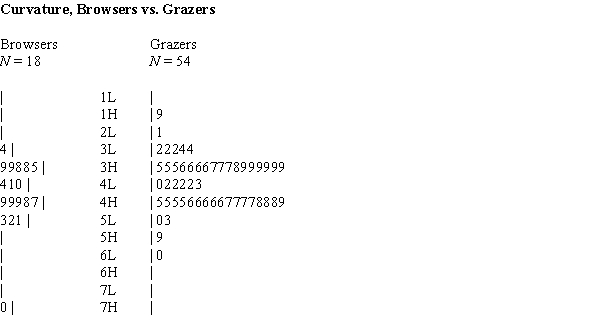Ruminants are hoofed animals such as cattle and sheep. Two categories of ruminants are browsers (leaf eaters) and grazers (grass eaters). Some biologists believe that the incisor arcade, that part of the mouth between the incisors, is shaped differently for browsers and grazers, and that might explain their food selection. The "curvature" of an incisor arcade is a measure of its shape, with large values indicating a long, thin mouth, and small values a shorter, wider mouth. The back-to-back stem plot below compares the curvatures of incisor arcades of a sample of species of browsers and grazers in the ruminant family. 
(a)Briefly describe each of the two curvature distributions, browsers and grazers, noting any unusual features of the data.
(b)The theory of some biologists is that browsers have thinner mouths because the browse plants frequently have thorns and spines; browsers have evolved to have thinner mouths to get beyond the thorns and spines to the food part of the plant. Is the data in the back-to-back stem plot consistent with this theory? What aspect of the data would you consider when answering this question?
Definitions:
Q17: A researcher wants to find out if
Q22: Which of the following statements is a
Q24: Overall the efficacy of all antidepressants is
Q34: Consider the chance experiment in which a
Q37: Which of the following random variables are
Q38: Psychologists have noted that people tend make
Q43: The researchers suggested that the time of
Q43: If there is no evidence of a
Q72: Refer to Scenario 1.2. Paws and Claws'
Q91: The most common purchases on account include<br>A)